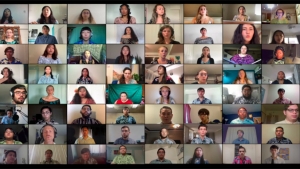“It’s important as an educator and also an educator of artists to model the power of flexibility and the power of remaining fluid throughout trying times,” said Jace Saplan, University of Hawaiʻi at Mānoa director of choral activities and assistant professor.
COVID-19 has changed the environment of everyday life and that is no more true than for UH Choirs. A program that relishes on singing and learning in-person, Saplan and his team researched, informed and implemented a plan not once, but twice, to maintain a valuable learning experience for students.
“Even when I am anxious about the rest of this semester and what the following year will bring, I remember the things that I am in control of and take the days as they come,” said Megann Salā, choral graduate assistant and graduate student in choral conducting. “Knowing that I am part of a supportive department led by teachers who advocate for my learning, I do what I can to help myself and others.”
New COVID-19 policies

UH Choirs is made up of three groups: chamber singers, concert choir and university chorus. The instruction team spent the summer planning for a hybrid learning model of online instruction and limited, safe in-person learning. Using expert guidance, the team planned to require wearing face masks at all times, even when singing, and instruction was to be held at the outdoor Barbara Smith Amphitheater or in the choir room with wall panels removed allowing for outside air. Singers were to be spaced out at least 12 feet apart and groups rotated. If students did not feel comfortable attending in-person classes, they were allowed to participate solely online.
However, as Honolulu stay-at-home/work-from-home orders were announced during the first week of instruction, classes were moved completely online. This came with a challenge unique to the performing arts—the difficulty of coordinating a synchronous performance virtually from different locations. Signal delays make it nearly impossible for students to sing in unison and listen to the various voices.
With input from students, the team decided to host a virtual concert at the end of the semester, matching choral performances with interviews from frontline workers helping Hawaiʻi overcome COVID-19. The performances, recorded individually—and showcased on their own or compiled into group performances—surround the theme “pono kaulike” or justice for all.
“It’s taking a look at how local music and choral music can be a catalyst for change and a catalyst for building resolve amongst communities,” Saplan said.
The students will perform works by local, national and international composers, and students will be responsible for the entire production.
“We will look at works by Queen Liliʻuokalani and how her compositions have fostered a sense of resilience within her lāhui—within her nation,” Saplan said. “We will be taking a look at compositions by Black composers and how those works connect to our responsibility as musicians within this climate of a racial uprising in America. We will be taking a look internationally to Estonia and how the choral music from Estonia has emboldened this country to use music as a form of nonviolent resistance to combat cultural genocide.”
Maintaining communication
Throughout the process of adjusting to new COVID-19 guidelines, Saplan and his team were in constant contact with each other and their students.
“We’ve been working really hard to be as transparent as we can be,” Saplan said. “From the very beginning, we’ve been reaching out to our incoming freshmen, to our incoming graduate students and to those who are returning that things will change, things might change and we have to be flexible and so I think they stepped into the semester with that mindset.”
Sophomore music major and choir student Kacey Chong said the transition to fully online learning was made easier because there is “a sense of family with one another.”
“I’m really impressed that my choir instructors are able to transform an in-person class into an online class,” Chong said. “And it is as intriguing as it would be if we were physically together. Everyone in my class is understanding and willing to adapt.”
Saplan added, “The transition took a lot of work and it took a lot of patience. It took a lot of trial and error in a short amount of time, but one thing I am so inspired by our team, by our faculty, by our students is that we are committed to using music as a change agent for good.”
Related UH News story: UH Mānoa Choirs share virtual mele, May 12, 2020
—By Marc Arakaki

